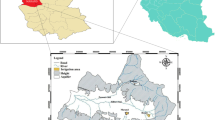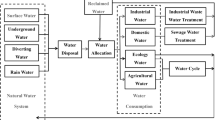Abstract
An inexact left-hand-side chance-constrained programming (ILCCP) was proposed and applied to a nonpoint-source water quality management problem within an agricultural system. The ILCCP model can reflect uncertainties presented as interval parameters (manure mass balance, crop nutrient balances, energy and digestible protein requirements, pollutant losses, water quantity constraints, technical constraints, and so on) and left-hand-side random variables (nitrogen requirement of crop i) at the same time. A non-equivalent linearization form of ILCCP was deduced and proved intuitively, which can help handle the left-hand-side random parameters in the constraints. The decision schemes through ILCCP were analyzed under scenarios at different individual probabilities (p i , denotes the admissible probability of violating the constraint i). The performance of ILCCP was also compared with the corresponding interval linear programming model. A representative nonpoint-source water quality management case was employed to facilitate the analysis and the comparison. The optimization results indicated that the net system benefit in the water quality management case would decrease with increasing probability levels on the whole. This was because that the higher constraint satisfaction of probability would lead to stricter decision space. The optimal scheme shows an obvious downtrend in the application amount of manure as the violation probability levels decreasing from scenarios 1 to 3 (p i = 0.1, 0.05 and 0.01). This demonstrates that the application amount of manure would be reduced effectively by adjusting strictness of the constraints. This study is the first application of the ILCCP model to water quality management, which indicates that the ILCCP is applicable to other environmental problems under uncertainties.






Similar content being viewed by others
References
Beck, M. B. (1987). Water quality modeling: a review of the analysis of uncertainty. Water Resources Research, 23(8), 1393–1442.
Cao, M. F., & Huang, G. H. (2011). Scenario-based methods for interval linear programming problems. Journal of Environmental Informatics, 17, 65–74.
Chen, B. (2007). Climate change and pesticide loss in watershed systems: a simulation modeling study. Journal of Environmental Informatics, 10(2), 55–67.
Ferguson, B., & Mudd, G. M. (2011). Water quality, water management and the ranger uranium project: guidelines, trends and issues. Water, Air, & Soil Pollution, 217(1–4), 347–363.
Füreder, L. (1999). Richard Helmer and Ivanildo Hespanhol (eds.), Water Pollution Control. A Guide to the Use of Water Quality Management Principles. Water, Air, & Soil Pollution, 110(3–4), 435–437.
Guo, P., & Huang, G. H. (2009). Two-stage fuzzy chance-constrained programming: application to water resources management under dual uncertainties. Stochastic Environmental Research and Risk Assessment, 23, 349–359.
Guo, H. C., Liu, L., Huang, G. H., Zou, R., & Yin, Y. Y. (2001). A system dynamics approach for watershed environmental management planning. Journal of Environmental Management, 61(1), 93–111.
Haith, D. A. (1982). Environmental systems optimization. New York: Wiley.
Huang, G. H. (1996). IPWM: an interval parameter water quality management model. Engineering Optimization, 26, 79–103.
Huang, G. H. (1998). A hybrid inexact-stochastic water management model. European Journal of Operational Research, 107, 137–158.
Huang, G. H., & Xia, J. (2001). Barriers to sustainable water quality management. Journal of Environmental Management, 61(1), 1–23.
Huang, G. H., Baetz, B. W., & Patry, G. G. (1992). A gray linear-programming approach for municipal solid-waste management planning under uncertainty. Civil Engineering Systems, 9, 319–335.
Huang, G. H., Baetz, B. W., & Patry, G. G. (1993). A grey fuzzy linear programming approach for waste management and planning under uncertainty. Civil Engineering Systems, 10, 123–146.
Julien, B. (1994). Water quality management with imprecise information. European Journal of Operational Research, 76, 15–27.
Li, Y. P., & Huang, G. H. (2010). Inexact joint-probabilistic stochastic programming for water resources management under uncertainty. Engineering Optimization, 42, 1023–1037.
Li, Y. P., Huang, G. H., & Nie, S. L. (2009). Water resources management and planning under uncertainty: an inexact multistage joint-probabilistic programming method. Water Resources Management, 23, 2515–2538.
Liu, L., Huang, G. H., Liu, Y., & Fuller, G. A. (2003). A fuzzy-stochastic robust programming model for regional air quality management under uncertainty. Engineering Optimization, 35(2), 177–199.
Loucks, D. P., Stedinger, J. R., & Haith, D. A. (1981). Water resource systems planning and analysis. Englewood Cliffs: Prentice-Hall.
Lu, H. W., Huang, G. H., & He, L. (2009). An inexact programming method for agricultural irrigation systems under parameter uncertainty. Stochastic Environmental Research and Risk Assessment, 23, 759–768.
Lv, Y., Huang, G. H., Li, Y. P., Yang, Z. F., & Sun, W. (2011). A two-stage inexact joint-probabilistic programming method for air quality management under uncertainty. Journal of Environmental Management, 92, 813–826.
Maqsood, I., Huang, G. H., Huang, Y. F., & Chen, B. (2005a). ITOM: an interval-parameter two-stage optimization model for stochastic planning of water resources systems. Stochastic Environmental Research and Risk Assessment, 19, 125–133.
Maqsood, I., Huang, G. H., & Yeomans, J. S. (2005b). An interval-parameter fuzzy two-stage stochastic program for water resources management under uncertainty. European Journal of Operational Research, 167, 208–225.
Ning, S. K., & Chang, N. B. (2004). Optimal expansion of water quality monitoring network by fuzzy optimization approach. Environmental Monitoring and Assessment, 91(1–3), 145–170.
Shastri, Y., & Diwekar, U. (2006). Sensor placement in water networks: a stochastic programming approach. Journal of Water Resources Planning and Management-ASCE, 132(3), 192–203.
Stachowicz, K. (1993). Nonpoint pollution from agricultural watersheds in the Carpathian Plateau (Southern Poland). Water, Air, & Soil Pollution, 69(1–2), 141–148.
Sun, W., Huang, G. H., Lv, Y., & Li, G. C. (2013). Inexact joint-probabilistic chance-constrained programming with left-hand-side randomness: an application to solid waste management. European Journal of Operational Research, 228(1), 217–225.
Tisdale, S. L., Nelson, W. L., & Beaton, J. D. (1985). Soil fertility and fertilisers (4th ed.). NewYork: Macmillan Publishing Company.
Tong, S. T. Y., Liu, A. J., & Grodrich, J.A. (2007). Climate change impacts on nutrient and sediment loads in a Midwestern agricultural watershed. Journal of Environmental Informatics, 9(1), 18–28.
Wang, S., Stiles, T., & Flynn, T. (2009). A modeling approach to water quality management of an agriculturally dominated watershed, Kansas, USA. Water, Air, & Soil Pollution, 203(1–4), 193–206.
Wu, S. M., Huang, G. H., & Guo, H. C. (1997). An interactive inexact-fuzzy approach for multiobjective planning of water environmental systems. Water Science and Technology, 36(5), 235–242.
Zhu, H., Huang, G. H., & Guo, P. (2012). SIFNP: simulation-based interval-fuzzy nonlinear programming for seasonal planning of stream water quality management. Water, Air, & Soil Pollution, 223(5), 2051–2072.
Acknowledgments
This research was supported by the Program for Innovative Research Team (IRT1127), Key Project of Ministry of Education (no. 311013), the 111 Project (no. B14008), the Natural Sciences Foundation (no. 51190095 and no. 51225904), National Basic Research Program (no. 2013CB430406 and no. 2013CB430401), and the Natural Science and Engineering Research Council of Canada. The authors are grateful to the editor and the reviewers for their insightful comments and suggestions in improving the quality of this paper.
Author information
Authors and Affiliations
Corresponding authors
Rights and permissions
About this article
Cite this article
Ji, Y., Huang, G.H. & Sun, W. Inexact Left-Hand-Side Chance-Constrained Programming for Nonpoint-Source Water Quality Management. Water Air Soil Pollut 225, 1895 (2014). https://doi.org/10.1007/s11270-014-1895-z
Received:
Accepted:
Published:
DOI: https://doi.org/10.1007/s11270-014-1895-z




